

“The Ophicleide - A Snake in the Brass”
An illustrated talk by Michael Bayliss, OP
1958-1965,
given to the Society of Old Priceans at the RAF Club, Piccadilly
on the occasion of the Christmas Luncheon held on 3rd December
2016
Introduction
A short while ago, I
was slightly taken aback when our President, Patrick Nobes,
asked me if I would speak at the 2016 SOP Christmas lunch about my “antique
instrument”. He quickly explained that he was not being personal but referring
to the rather unusual 19th century instrument that I play, the ophicleide, which is a bass member of the brasswind family. Unlike the brass of today, which other
than the slide trombone all have valves, the ophicleide is fitted with keys resembling those found on old flutes, only much larger.
I should first perhaps
explain why I play brass instruments at all, given that I was known at Price’s
as a CCF band fifer (as I still am for the London OPs when I ‘fife’ them into
dinner), and later on as an orchestral flautist. The Royal Navy is responsible
for the rot setting in, when in 1975 I joined HMS Seahawk, the air base at Culdrose in Cornwall. I was invited to join their voluntary
bluejacket band and duly turned up with my flute, on seeing which the Royal Marines
Colour Sergeant in charge exclaimed “You can’t bring that there ‘ere”, or words
to that effect, “this is a Silver Band.” I said mine was a silver flute: but apparently
it did not work like that, so I spent the next two years happily teaching
myself the bass tuba, the baritone & the euphonium. By happenstance, I later discovered
the existence of the ophicleide, then regarded as an
obsolete instrument of only historic interest, and immediately wanted one. “That’s
for me”, I thought, “a brass instrument with flute keywork”
– I did not then know that the fingering system is nothing at all like a
woodwind, or indeed any other, instrument. Ophicleides were virtually unobtainable at that time, of course, but as luck would have it an
antique specimen from about 1860 came on to the local market several years ago.
I bought it, had it restored and learned to play it – and now I have six, including
three modern replicas, as they have recently started to be manufactured again!
This talk will be in
two parts:
(1) a very brief overview of the development
of orchestral brass instruments up to the beginning of the 19th century, and how the ophicleide came to be invented;
(2) the golden age during the 19th century of an instrument that was ubiquitous in its day, is now largely forgotten
but which is at last re-emerging quite rapidly from obscurity.
1. The Origins Of The Ophicleide
The trail starts way
back in the 16th and 17th centuries with the cornetto, or cornett in English – always spelled with two T’s
to distinguish it from the modern brass band cornet, a completely
different instrument. Originally made from an ox or cow horn, the cornett was by that period made of wood covered in leather,
still made in a curve, and played with what looks like a miniature trumpet
mouthpiece. This classifies it technically as a brasswind instrument, but it has open recorder-style holes along its length. It is
fiendishly difficult to play well, but in late 17th century Venice
it had become a virtuoso’s instrument that rivalled the violin in popularity.
Different sizes of cornett were made, including the tenor (or ‘lyzard’) and a bass. However, of more interest to us in the
present context is a closely_related instrument, the serpent, named after its double_S
shaped body which was designed to make it easier to hold.
Serpentists like to think it was invented by
Moses: “Moses made a bronze serpent and set it on a pole” (Book of Numbers, Ch. 21, v. 9),
but the real inventor was Canon Edmé Guillaume of Auxerre, France, who intended it to serve as the bass to
the cornett family, since the true bass was very long
and unwieldy to play, not to mention rather rare. Guillaume’s intention was
that the serpent should underpin the singing of church and cathedral choirs in
France, which it did very successfully for the next two and a half centuries.
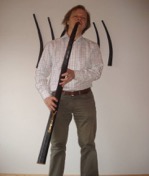
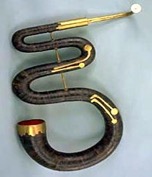
We now fast_forward to the baroque era of the 18th century to consider the orchestral
instruments of Bach and Handel’s time. The violins, violas and cellos looked
very much like those we have now, and the woodwind – flute, oboe, and bassoon –
are clearly recognisable as the forerunners of modern instruments: the clarinet
had not yet arrived on the scene. The line-up there was broadly similar to that
of a modern orchestra, although of more modest size. When we come to the brass, however, the
situation is very different: we find just trumpets and horns, and these were defective
in terms of playing scales as they could produce only the naturally_occurring
notes of the harmonic series, like a modern military bugle. It was possible to play very high up (‘clarino’) where the natural notes come closer together, but
this demanded a very advanced technique. There were normally no orchestral trombones,
although the instrument had already been in existence for a long time. Handel and others experimented with their
use, but they were generally reserved for religious music or town bands. And there was no proper bass brass instrument
available at all – so the serpent was taken out of its context as choral
support and, faute de mieux, pressed
into service in orchestras by contemporary composers and conductors.
Later in the 18th century, we come to the classical period of Mozart and Haydn, when orchestral
instruments remained much as they had been in the baroque era, with a few extra
keys on the woodwind and the addition of the clarinet and the piano. The brass instruments had barely
changed, although horn players had by now found they could get more notes by
moving their hand inside the bell. Trumpets were still ‘natural’, trombones were still not present – and still
no brass bass, so the serpent remained grudgingly in use.
However, there was a
growing desire to have a proper treble brass instrument. Various attempts were
made at developing a trumpet that could play extra notes, and this was eventually
perfected by Anton Weidinger around 1770-1780 with
his keyed trumpet. Concertos were written for it by Haydn (1796) and Hummel
(1803) which remain major works in the repertoire, although now played on a
quite different type of instrument. Michele Puccini (father of the opera
composer) was writing for it even late as 1838.
We tend to forget that
while Haydn was a contemporary of Mozart, he also overlapped with the early
Romantic period and its principal composer, Beethoven. It was the latter who was instrumental
in installing trombones as permanent members of the symphony orchestra by the beginning
of the 19th century. But even by that time, the horns were still
hand-horns, the trumpets were still for the most part ‘natural’– and there was still no proper bass brass instrument! However, that was about to change.
The keyed trumpet did
not catch on generally, possibly because Weidinger himself was very secretive about it, possibly because one critic said it
sounded like a “demented oboe”, but there were attempts to do the same thing
with the bugle – or rather, the flugelhorn, which originally played only the ‘natural’
notes and was used in a military signalling context. In 1811, a maker named
Halliday patented a keyed instrument which he called the ‘Royal Kent Bugle’, in
honour of the Duke of Kent. Unlike
the keyed trumpet, this proved a roaring success with the wind bands of the
time since it gave them a high brass instrument capable of playing tunes in any
key, the cornett having long since disappeared. It
was manufactured by, among others, the Distin brothers of London, who were both makers and performers. One of them, John Distin, was unwittingly to play a crucial part in
causing the ophicleide to come into being.
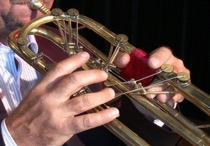
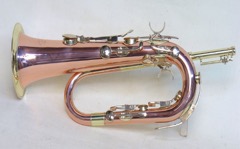
Left: Keyed Trumpet Right: Keyed (Royal Kent) Bugle
Not long afterwards, in 1815, there
occurred a momentous event on the history of Europe: the battle of
Waterloo. When the Allied troops were marching through Paris later that year,
the procession included the band of the Coldstream Guards, among whom was John Distin, their star performer on the keyed bugle. History
relates that one of the Allied commanders, Grand Duke Constantine of Russia,
heard Distin playing it and immediately wanted one
for his own band. A Parisian
instrument maker named Jean-Hilaire Asté, generally known as Halari,
was given the task of making a copy. He did so, and gave it a French name, the
‘clavitube’. But Halari went
further and created a whole family of keyed brasswind instruments. These included an alto (which he called a ‘quinticlave’,
playing in E flat at the ‘quint’ or fifth below the bugle in B flat) and a bass:
and so begins the era of the ophicleide, as Halari named the latter for reasons that we shall see.
2. The Golden
Age Of The Ophicleide
The ophicleide was patented by Halari in 1821 – exactly 100 years
after our founder William Price made his will – but it must have been already in
use well before that, as its first recorded appearance was in Paris in 1817,
played by a trombonist, in Spontini’s opera Olympie. (It
is interesting also to note the preface to an 1835 tutor book for the ophicleide by a French music professor, Cornette,
in which he refers to the origins of the instrument “in the period following
the invasion by foreign troops after 1814”. No reference to the battle, or to Napoleon’s
defeat, or the aftermath – a definite case of “Don’t mention the war”!)
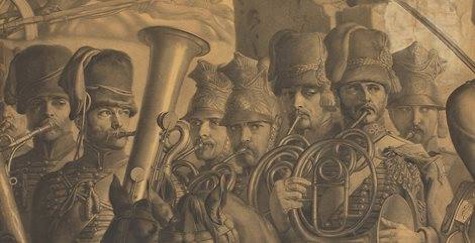
In 2015, to coincide with
the 200th anniversary of the Battle of Waterloo, the Royal Academy
exhibited Daniel Maclise’s 1859 cartoon of The Meeting of Wellington and Blücher after the Battle, which is about 40 feet wide and one of the largest of such cartoons in the UK. It was produced in preparation for a
prestigious commission of a wall painting in the Houses of Parliament, which is
still on display. Above is a detail from the cartoon depicting military
bandsmen, including two ophicleidists. There is just one slight problem – in
1815, the ophicleide had not yet been invented!
Why did Halari give the new instrument such a strange name? It
comes from two Greek words, ophis meaning ‘snake, ‘serpent’, and kleide meaning ‘lid’, ‘covering’:
so the ophicleide is literally a ‘serpent with
covered keyholes’. It is, of
course, not a serpent at all – it is technically a bass flugelhorn – but
this was a marketing ploy by Halari, who hoped it
would replace serpents in bands and orchestras: which indeed it did.
The problem with the
serpent was that when it was played loudly enough to be heard in an orchestra,
this both forced the tone, making it coarse, and caused major tuning problems,
already difficult enough on an instrument where, owing to limitations imposed
by the stretch of the human hand, the finger holes are not in the right place
anyway. Although attempts were made to improve the serpent in the late 18th and early 19th centuries, these did not really solve the problem.
The instrument was abandoned relatively quickly, with the ophicleide substituted in its place as Halari had intended.
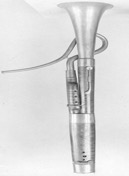
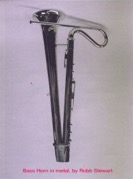
Two ‘improved’ serpents in
straightened form.
Left: a so-called “Russian
bassoon”. Right: an “English bass horn”, made entirely of brass.
Handel said in 1710
that “It was certainly not the serpent
that seduced Eve”, while in 1783 music critic Charles Burney averred that
it was “like a huge, hungry, or rather
angry, Essex calf, badly blown and out of tune.” One commentator observed in 1844 that “it might be dropped from the family of
wind instruments without the slightest injury to art.”
Not everyone approved.
In its early days, some people complained that the bass end of the orchestra
was being swamped by the loudness of the trombone & ophicleide section. Nothing changes – they still say the same thing, nearly two centuries
later, about the trombones and tuba, which are now considerably louder than in
the 19th century!
George Bernard Shaw
complained that the ophicleide sounded like a
“chromatic bullock”, and it is certainly very easy to play the thing badly and
with poor tone. But Shaw changed
his mind when he heard the great virtuoso Sam Hughes performing his signature
piece, the famous bass aria ‘O Ruddier Than The Cherry’ from Handel’s opera Acis & Galatea.
The fact that their
instrument it is not the easiest to play may account for ophicleidists having had a general reputation for madness. Virginia Woolf once wrote in a
letter to a friend: “his father played the ophicleide... and died
insane, as they all do", while an article from the Irish Times of 3rd March 1945 informs us that: “one of George Bernard Shaw’s uncles played the ophicleide…
and studied the figures of bathing belles through an opera glass, before committing
suicide by stuffing his head in a carpet bag.”
Berlioz was one of the
first major composers to exploit the ophicleide, although he
hated the keyed bugle itself. (He expressed the view that its name must
have come from the French verb ‘beugler’, meaning ‘to bellow like a cow’.) However, he saw the usefulness of the
bass instrument, despite complaining in his Treatise
On Harmony that the ophicleide was not taught well and good players were rare –
which may have contributed to the poor impression some people had of it
originally. Berlioz also remarked
in a letter that “of the hundreds who
blow this instrument in Paris, there are only two or three who can play it
properly in tune” and he regretted that it was not taught at all in the
Paris Conservatoire of Music. But he later met a French virtuoso
named Caussinus, a former oboist who had taken up the
new invention, and began to change his opinion: certainly, since that meeting
the ophicleide parts in Berlioz’s works become more
developed and extended in range.
Berlioz also mentions the rather
rare contrabass ophicleide, or ‘ophicléide-monstre’ as it was
known. He said it would be a very useful addition to the orchestra but no-one
in Paris at that time would play one as it was claimed they demanded too much
air!
It is interesting that, despite
his earlier disparaging remarks about the ophicleide,
Berlioz even gave it an on-stage solo in his opera Benvenuto Cellini. And he never did
like the new_fangled tuba, even when that became available to him later on.
Mendelssohn was
another early ophicleide enthusiast. He wrote parts
for it in several of his works, including his overture to A Midsummer Night’s Dream and his oratorio Elijah. When the latter was premiered at the Birmingham
festival in 1834, Mendelssohn included a contrabass ophicleide.
(Two years ago, the BBC undertook a recreation of Elijah using original period instruments. Tony George, professor of
tuba at the Royal Academy of Music, played the contrabass: one of only two
playable ones in the world, both of which are modern replicas).
The ophicleide soon established itself as the normal bass of the orchestral brass, and it was
subsequently so regarded by composers right up to the time of Verdi and Wagner,
who both included it in their earlier works.

Ophicleide made circa 1850 by the firm of Gautrot (Paris)
In orchestras, ophicleides were invariably required to play low down, both
as the bottom end of the trombone section and to reinforce the bass line
generally. It was rather different in the early brass bands, which had both
high & low ophicleides: the first player used a
smaller mouthpiece and his part corresponded to that of a present_day
euphonium, while the second player had a large mouthpiece and played what would
now be the bass tuba part. The alto ophicleide took
the place of the modern tenor horn.
Anecdotes about ophicleides in bands are legion. My favourite is that
relating to Stalybridge Brass Band, who apparently lost the 1860 championship
contest at Crystal Palace when their first ophicleide player got his pocket watch chain caught up in the keys of his instrument!
Unlike the orchestras,
where it seems the standard of brass playing was generally not high in the earlier
part of the 19th century, the band movement produced many fine
players. Amateur musicians, miners,
millworkers and factory hands, they might be illiterate in English but could
certainly read music and had the technique to cope with highly lavish and
complex arrangements of the operatic music of the day. Professional ophicleidists included Sam Hughes already mentioned, the greatest player in England if not
the world. I have a copy of a photo
taken in the latter half of the century of the professors at Kneller Hall,
the Army’s school of music. The line-up includes Hughes on ophicleide, Alfred Phasey,
another great ophicleidist who went on to become one
of the first euphonium virtuosos, and Tom Sullivan, professor of the then_new
tuba: he was the father of Sir Arthur Sullivan, of Gilbert & Sullivan fame,
who also used the ophicleide in some of his works.
The mid-19th century saw the phenomenon of the promenade concert. Louis_Antoine Jullien was a
Frenchman, based in England for about twenty years from 1838, who effectively
created the ‘prom’ in England well before Sir Henry Wood and the BBC came
on the scene. Jullien’s mix of light music and the classics for the ‘promenaders’
helped to bring orchestral music to a wider popular audience.
Jullien was a great showman who attracted some
of the best players from England and France, and at one point he even engaged
Berlioz to conduct. One of his star soloists on numerous occasions was the
French ophicleide virtuoso ‘Prospère’
(Jean-Prospère Guivier), who liked to use the contrabass: since
he was a shortish man, the incongruity must have
appealed to Jullien, and doubtless the audience. This caused Punch magazine to comment in 1852 on Jullien’s “gratuitous overuse of the ophicleide” and add
this ditty:
“With ophicleide,
cymbals and gongs,
At first thou did’st wisely begin,
And bang the dull ears of the popular
throngs,
As though 'twere to
beat music in.”
|
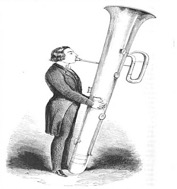
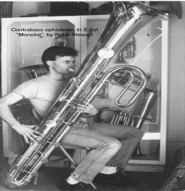
Left: 1844 caricature from Punch magazine of virtuoso player 'Prospère' with his “monstre” or
contrabass ophicleide. Right: replica contrabass ophicleide being
played by its maker, Robb Stewart, in the 1980s. (This is the instrument used by the
BBC in the period performance of Elijah mentioned previously).
All good things must come
to an end and, eventually, towards the end of 19th century,
the ophicleide started to fade out. I believe
there were two principal reasons for this:
(a) Bands were going
over exclusively to the new saxhorn family of brass instruments invented or
developed by Adolphe Sax. These all have piston
valves and are much easier to play than keyed bugles and ophicleides.
In addition, they were subject to active marketing: winners of contests on the ophicleide were known to have received euphoniums as
prizes! In the orchestra, too,
trumpets and horns were adopting the new valves. They also started to be
applied to ophicleides, with the subsequent
development of a much larger instrument, the ‘bombardon’, which was the forerunner
of the modern tuba.
(b) Orchestras were
getting bigger & louder, as they had started to do in Handel’s day and are
still doing now. The earlier brasswind simply did not
have sufficient carrying power and were gradually replaced by larger wide_bore
instruments, while the ophicleide was eventually
supplanted by the heavyweight tuba – which, as a contrabass instrument, now
often plays the ophicleide part of 19th century works an octave lower than intended.
The ophicleide was, nevertheless, quite a long time a_dying. Older players saw no reason to learn a new
instrument, so it lasted as long as they did. The firm of Couesnon still had ophicleides in its catalogue in 1910 and
did not actually stop manufacturing them until about 1920. The instrument prevailed the longest
in Brazil, of all places, where the ‘choro’ dance bands are known to have
retained it into the 1930s at least.
And in one sense, it
never died anyway, just changed. Legend relates that Adolphe Sax, looking as always for a new sound, wondered what would happen if he were
to place a bass clarinet mouthpiece on an ophicleide – and so the saxophone was conceived, that Frankenstein monster of an
instrument consisting of an ophicleide body with the
reed of a clarinet and the fingering of a flute!
The purported end of the ophicleide has inspired numerous poems. Brian Holmes, a.k.a. ‘Professor
Cabbage’, wrote one which ends:
Farewell, O ancient ophicleide,
Your epitaph is chiseled:
“I died of ophicleidicide.
I tried,
alas, but fizzled!”
But methinks its demise is much exaggerated. Many brass players are again taking up this allegedly
obsolete instrument for its unique value. I would argue that the ophicleide is not, as is usually asserted, ‘the precursor of the tuba’ but, to
quote a statement made about the Welsh crwth or
crowd, “Historically, it represents the logical end of one particular line of
development, not the early stage of another.” Musical instruments all seem to
go through a similar life cycle: at first, they are simply the norm; then they
become old-fashioned; then obsolescent, and finally obsolete. But if one waits a
little longer, they may come back as ‘period’ instruments – as the ophicleide is now doing. It is again being used by professional
orchestras and ensembles in historical performance to recreate the sound_world
of the mid_19th century brass, alongside period horns &
trumpets and narrow-bore trombones, where the timbre, and volume, of a modern
tuba is totally out of place. In
the earlier part of the last century, recorders were regarded as no more than
historic curiosities, and just look at their popularity today: perhaps the same
may yet happen to the ophicleide!
Another major reason
for its resurgence is that, as in my own case, a growing number of people are adopting it because of its totally distinctive
sound. As happened with the re_emergence
of the recorder, works are again being written for it by modem composers.
I leave the last word to cellist Yo-Yo-Ma:
"If you love the sound of some musical instrument, it's like no
other sound. It’s really yours, it comes from deep within... You can express how you feel, send
yourself into the larger world. You will always have that voice, and that's a
pretty powerful thing."
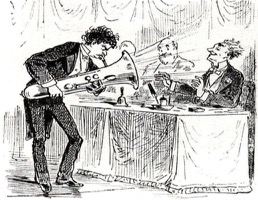
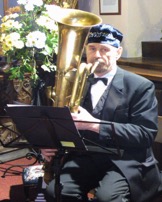
“The Competitive Music Festival” The ophicleide in the 21st century:
(mid-19th century French cartoon) Mike Bayliss with the Petrovian Orchestra
playing the ophicleide part in the march from
Meyerbeer’s Le Prophète